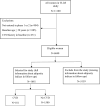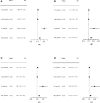Adiposity trajectories and cardiovascular disease risk in women: a population-based cohort study with a focus on menopausal status
- PMID: 38854691
- PMCID: PMC11157004
- DOI: 10.3389/fendo.2024.1389330
Adiposity trajectories and cardiovascular disease risk in women: a population-based cohort study with a focus on menopausal status
Abstract
Objectives: A single measurement of adiposity indices could predict the incidence of cardiovascular disease (CVD); nonetheless their long-term pattern and its association with incident CVD are rarely studied. This study aimed to determine distinct trajectories of adiposity indices among participants of Tehran Lipid and Glucose Study (TLGS) and their association with incident CVD. Furthermore, this study aimed to investigate whether this association differed among individuals according to their menopausal status.
Method: A total of 6840 women participated in TLGS, aged 20 years and older were included in this study; they were followed for a median of 16 years. Body mass index (BMI), waist circumference (WC), conicity index (CI) and body roundness index (BRI) were included in the analysis as adiposity indices. The cohort outcome panel of medical specialists identified the CVD outcomes. Trajectory analyses were used to identify homogeneous distinct clusters of adiposity indices trajectories. The association between the trajectory group membership and incident CVD were explored by Cox proportional hazard models, with unadjusted and adjusted model for baseline age, physical activity, smoking status, menopause and family history of CVD.
Results: Three BMI trajectory groups of low, medium, and high and two trajectories for WC, BRI and CI were identified. Adjusted cox proportional hazard models revealed significant associations between the hazard of CVD experience and the high trajectory group of the BMI (HR: 2.06, 95% CI: 1.38-3.07), WC (HR: 2.71, 95% CI: 1.98-3.70), CI (HR: 1.87, 95% CI: 1.26-2.77) and BRI (HR: 1.55-95% CI: 1.12-2.15), compared to the low trajectory group. Subgroup analysis based on the menopausal status of participants showed that the HR of CVD incidences for all of trajectories adiposity indices, except BMI, was statistically significant. Adjusted cox proportional hazard models, in those women not reached menopause during study, revealed that the HR (95% CI) of CVD incidences for high trajectory of BMI, WC, CI and BRI were 2.80 (1.86-7.05); 2.09 (1.40-6.16); 1.72 (1.42-5.61), and 3.09 (1.06-9.01), respectively. These values for those were menopause at the initiation of the study were 1.40 (1.11, 2.53); 1.65 (1.04-2.75); 1.69 (1.01-2.87), and 1.61 (0.98-2.65), respectively.
Conclusion: Our findings suggest that adiposity trajectories, particularly central adiposity index of CI, could precisely predict the CVD risk. Consequently, preventive strategies should be tailored accordingly.
Keywords: adiposity indices; body mass index (BMI); body roundness index (BRI); cardiovascular disease (CVD); conicity index (CI); tehran lipid and glucose study (TLGS); trajectory; waist circumference (WC).
Copyright © 2024 Firouzi, Ramezani Tehrani, Kaveh, Mousavi, Azizi and Behboudi-Gandevani.
Conflict of interest statement
The authors declare that the research was conducted in the absence of any commercial or financial relationships that could be construed as a potential conflict of interest.
Figures



Similar articles
-
Impact of adiposity indices changes across the lifespan on risk of diabetes in women: trajectory modeling approach.BMC Public Health. 2024 Sep 6;24(1):2429. doi: 10.1186/s12889-024-19996-4. BMC Public Health. 2024. PMID: 39243051 Free PMC article.
-
Predictive Capability of Dual Trajectories of Central Adiposity Indices Combined With Glucose for Cardiovascular Diseases.J Diabetes. 2025 Apr;17(4):e70081. doi: 10.1111/1753-0407.70081. J Diabetes. 2025. PMID: 40276925 Free PMC article.
-
Entering a new era of body indices: the feasibility of a body shape index and body roundness index to identify cardiovascular health status.PLoS One. 2014 Sep 17;9(9):e107212. doi: 10.1371/journal.pone.0107212. eCollection 2014. PLoS One. 2014. PMID: 25229394 Free PMC article.
-
Association of body roundness index with cardiovascular disease in patients with cardiometabolic syndrome: a cross-sectional study based on NHANES 2009-2018.Front Endocrinol (Lausanne). 2025 Feb 3;16:1524352. doi: 10.3389/fendo.2025.1524352. eCollection 2025. Front Endocrinol (Lausanne). 2025. PMID: 39963283 Free PMC article. Review.
-
Associations of obesity indices change with cardiovascular outcomes: a dose-response meta-analysis.Int J Obes (Lond). 2024 May;48(5):635-645. doi: 10.1038/s41366-024-01485-8. Epub 2024 Feb 9. Int J Obes (Lond). 2024. PMID: 38336864 Review.
Cited by
-
Joint association of triglyceride glucose index (TyG) and body roundness index (BRI) with stroke incidence: a national cohort study.Cardiovasc Diabetol. 2025 Apr 16;24(1):164. doi: 10.1186/s12933-025-02724-6. Cardiovasc Diabetol. 2025. PMID: 40241070 Free PMC article.
-
Association between changes in the triglyceride glucose-body roundness Index and cardiovascular disease risk in middle-aged and elderly Chinese adults: a nationwide longitudinal study from 2011 to 2015.Front Nutr. 2025 Jul 11;12:1560617. doi: 10.3389/fnut.2025.1599601. eCollection 2025. Front Nutr. 2025. PMID: 40717993 Free PMC article.
References
-
- Mohammadian Khonsari N, Khashayar P, Shahrestanaki E, Kelishadi R, Mohammadpoor Nami S, Heidari-Beni M, et al. . Normal weight obesity and cardiometabolic risk factors: A systematic review and meta-analysis. Front Endocrinol (Lausanne). (2022) 13:857930. doi: 10.3389/fendo.2022.857930 - DOI - PMC - PubMed
MeSH terms
LinkOut - more resources
Full Text Sources
Medical

